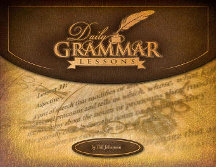Daily Grammar is a free online grammar study program with lessons written by Bill Johansen, an English teacher with 30 years of experience.
While it is not set up by grade levels, it is organized topically with lessons becoming progressively more difficult for each topic. An archive lists lessons by topic area with direct links to each lesson. A quiz is provided for every four or five lessons; these are also linked directly from the archive. Answers are printed on the same web page for each lesson or quiz, but you have to scroll down to see them. Since students should respond with written answers—including sometimes rewriting a paragraph or more—it should work best to print out the pages. Generally, this will place the answer key on a separate page from the lesson.
Lessons themselves are rather brief. They state the point of grammar or the rule and include an example. This might be sufficient for students in junior and senior high, but younger students might need expanded instruction at a simpler level with additional examples.
There are 440 lessons and 88 quizzes on the site. The first 90 lessons cover all eight parts of speech. Lessons 91 through 300 teach usage and syntax covering topics such as direct objects, predicate nominatives, prepositional phrases, clauses, verbals, and compound sentences; this section is called “Parts of the Sentence.” The remaining lessons, called “Mechanics,” cover capitalization and punctuation. The “Parts of Speech” and “Parts of Sentences” lessons include review lessons that cover a number of topics. For example, after studying the parts of speech, a review lesson asks students to identify each word in three sentences as one of the eight parts of speech. Note that sentence diagramming is not taught.
The lessons and quizzes could be split up for use over a few years, although lessons are so brief that a diligent student might be able to complete all of them in one year by completing a number of lessons per day. If you were to split them up, you might not use all of the lessons in order. Instead, you might use the first five lessons on pronouns the first year and the second five lessons on pronouns the second year. You would have to decide how much to cover on each topic according to the needs of each student. Below the archive is another index that is arranged like a true index in alphabetical order by topic. This index lists detailed subcategories making it easy to get to a lesson to target a very specific topic. I very much appreciate these two options for accessing lessons. Both work well, and you can always use either one.
Students who simply need to review grammar on a regular basis might want to sign up for the free email service for the “Daily Grammar Blog.” Each day Monday through Friday one of the lessons is posted on a blog with a quiz posted on Saturday. While you can access the blog directly, signing up delivers a lesson a day to a student's email account.
Those who like the concept of Daily Grammar but prefer a printed book can order the Daily Grammar Lessons Workbook that contains all of the lessons and quizzes. ($23.50) The workbook has answers printed directly on the bottom of each page, so this might not work well for students who are tempted to use the answer keys too freely. Two ebook versions of the workbook are available for $6.95 each. One, called the Daily Grammar Lesson eBook, is a PDF file. The other, Daily Grammar FlipBook, is a “flippable” book that allows note taking and highlighting. Both versions are printable. Both include answers either on the same page as the lessons or on the next page.
The Daily Grammar site might prove to be sufficient grammar instruction and practice for students in junior and senior high. The brief lessons make it especially useful for students who are reviewing and polishing their grammar skills learned in earlier years rather than for a student who lacks prior grammar instruction. Since it's free, you've got nothing to lose and much to gain by trying it out to see if it works for you.









